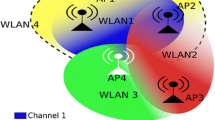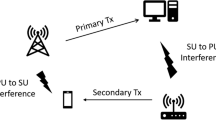Abstract
Idle Sense is an optimal channel access scheme to achieve high throughput with high short-term fairness in IEEE 802.11 style wireless LANs. This paper recovers a non-cooperative game model from the protocol. We show that the control algorithm used by Idle Sense can be reverse-engineered so that each node implicitly maximizes a selfish local utility function. We prove the game has a Nash equilibrium which, under certain conditions, is unique with all nodes sharing the wireless channel equally. We perform extensive numerical simulations to get the equilibrium point for various network sizes and compare the performance of the model with IEEE 802.11 DCF. The achieved throughput at equilibrium is close to optimal.
Similar content being viewed by others
Explore related subjects
Discover the latest articles, news and stories from top researchers in related subjects.References
IEEE 802.11b/d3.0 wireless LAN medium access control (MAC) and physical layer (PHY) specification. August 1999.
Heusse, M., Rousseau, F., Guillier, R., & Duda, A. (2005). Idle sense: an optimal access method for high throughput and fairness in rate diverse wireless LANs. In SIGCOMM ’05: proceedings of ACM conference on applications, technologies, architectures, and protocols for computer communications, Philadelphia, PA, USA, August 2005.
Lin, H., & McDonald, D. (2009). Lock step: an algorithm to reduce WiFi jitter. IEEE Communications Letters, 13(7), 501–503.
Saraydar, C., Mandayam, N. B., & Goodman, D. J. (2002). Efficient power control via pricing in wireless data networks. IEEE Transactions on Communications, 50(2), 291–303.
Kelly, F. P., Maulloo, A. K., & Tan, D. K. H. (1998). Rate control in communication networks: shadow prices, proportional fairness and stability. The Journal of the Operational Research Society, 49, 237–252.
Jin, Y., & Kesidis, G. (2002). Equilibria of a noncooperative game for heterogeneous users of an Aloha network. IEEE Communications Letters, 6(7), 282–284.
Xiao, Y., Shan, S., & Ren, Y. (2005). Game theory models for IEEE 802.11 DCF in wireless ad hoc networks. IEEE Communications Magazine, 45(3), S22–S26.
Lee, J. W., Tang, A., Huang, J., Chiang, M., & Calderbank, R. (2007). Reverse-engineering MAC: a non-cooperative game model. IEEE Journal on Selected Areas in Communications, 25(6), 1135–1147.
Tang, A., Lee, J. W., Huang, J., Chiang, M., & Calderbank, R. (2006). Reverse-engineering MAC. In WiOpt ’06: proceedings of the 4th international symposium on modeling and optimization in mobile, ad hoc, and wireless networks, Boston, Massachusetts, April 2006.
Lee, J. W., Chiang, M., & Calderbank, R. (2006). Utility-optimal medium access control: reverse and forward engineering. In INFOCOM ’06: proceedings of the 25th IEEE international conference on computer communications, Barcelona, Spain, April 2006.
Chen, L., Cui, T., Low, S. H., & Doyle, J. C. (2007). A game-theoretic model for medium access control. In WICON ’07: proceedings of the 3rd annual international wireless Internet conference, Austin, Texas, October 2007.
Ganchev, A., Narayanan, L., & Shende, S. (2008). Games to induce specified equilibria. Theoretical Computer Science, 409(3), 341–350.
Fabrikant, A., & Papadimitriou, C. H. (2008). The complexity of game dynamics: BGP oscillations, sink equilibria, and beyond. In SODA 08: proceedings of the 19th annual ACM-SIAM symposium on discrete algorithms, pp. 844–853, San Francisco, California, USA, January 2008.
Bianchi, G., & Tinnirello, I. (2003). Kalman filter estimation of the number of competing terminals in an IEEE 802.11 network. In INFOCOM ’03: proceedings of the 22nd IEEE international conference on computer communications, San Francisco, USA, March 2003.
Vercauteran, T., Toledo, A. L., & Wang, X. (2005). Online Bayesian estimation of hidden Markov models with unknown transition matrix and applications to IEEE 802.11 networks. In ICASSP ’05: proceedings of the IEEE international conference on acoustics, speech, and signal processing, Philadelphia, USA, March 2005.
Toledo, A. L., Vercauteran, T., & Wang, X. (2006). Adaptive optimization of IEEE 802.11 DCF based on Bayesian estimation of the number of competing terminals. IEEE Transactions on Mobile Computing, 5(9), 1–14.
Bononi, L., Conti, M., & Gregori, E. (2004). Runtime optimization of IEEE 802.11 wireless LANs performance. IEEE Transactions on Parallel and Distributed Systems, 15(1), 66–80.
Ni, Q., Aad, I., Barakat, C., & Turletti, T. (2004). Modeling and analysis of slow CW decrease for IEEE 802.11 WLAN. In INFOCOM ’04: proceedings of the 23rd IEEE international conference on computer communications, Hong Kong, China, March 2004.
Mackenzie, A. B., & Wicker, S. B. (2001). Selfish users in Aloha: a game-theoretic approach. In VTC ’01 (Fall): proceedings of IEEE vehicular technology conference, Atlantic City, NJ, October 2001.
Altman, E., El-Azouzi, R., & Jiménez, T. (2004). Slotted Aloha as a game with partial information. Computer Networks, 45(6), 701–713.
Pongsajapan, J., & Low, S. H. (2007). Reverse engineering TCP/IP-like networks using delay-sensitive utility functions. In INFOCOM ’07: proceedings of the 26th IEEE international conference on computer communications, Alaska, USA, May 2007.
Chen, L., Low, S. H., & Doyle, J. C. (2007). Contention control: a game-theoretic approach. In CDC ’07: proceedings of the 46th IEEE conference on decision and control, pp. 3428–3434, New Orleans, LA, December 2007.
Sanyal, D. K., Chattopadhyay, M., & Chattopadhyay, S. (2008). Improved performance with novel utility functions in a game-theoretic model of medium access control in wireless networks. In TENCON ’08: proceedings of the IEEE region 10 conference, Hyderabad, India, November 2008.
Sanyal, D. K., Chattopadhyay, M., & Chattopadhyay, S. (2009). Performance improvement of wireless MAC using non-cooperative games. In S. I. Ao & L. Gelman (Eds.), Lecture notes in electrical engineering: Vol. 39. Advances in electrical engineering and computational Science (pp. 207–218). Berlin: Springer. Chap. 18.
Bianchi, G. (2000). Performance analysis of IEEE 802.11 distributed coordination function. IEEE Journal on Selected Areas in Communications, 18(3), 535–547.
Chiu, D., & Jain, R. (1989). Analysis of the increase and decrease algorithms for congestion avoidance in computer networks. Computer Networks and ISDN Systems, 17(1), 1–14.
Xiao, M., Shroff, N. B., & Chong, E. K. P. (2001). Distributed admission control for power-controlled cellular wireless systems. IEEE/ACM Transactions on Networking, 9(6), 790–800.
Lin, H., Chatterjee, M., Das, S. K., & Basu, K. (2005). ARC: An integrated admission and rate control framework for competitive wireless CDMA data network using noncooperative games. IEEE Transactions on Mobile Computing, 4(3), 243–258.
Maxima, http://maxima.sourceforge.net/.
Author information
Authors and Affiliations
Corresponding author
Rights and permissions
About this article
Cite this article
Sanyal, D.K., Chattopadhyay, M. & Chattopadhyay, S. Recovering a game model from an optimal channel access scheme for WLANs. Telecommun Syst 52, 475–483 (2013). https://doi.org/10.1007/s11235-011-9450-3
Published:
Issue Date:
DOI: https://doi.org/10.1007/s11235-011-9450-3




